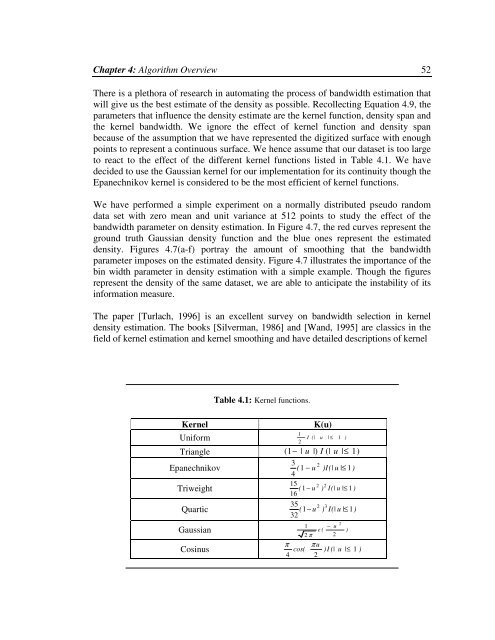To the Graduate Council: I am submitting herewith a thesis written by ...
To the Graduate Council: I am submitting herewith a thesis written by ...
To the Graduate Council: I am submitting herewith a thesis written by ...
Create successful ePaper yourself
Turn your PDF publications into a flip-book with our unique Google optimized e-Paper software.
Chapter 4: Algorithm Overview 52There is a plethora of research in automating <strong>the</strong> process of bandwidth estimation thatwill give us <strong>the</strong> best estimate of <strong>the</strong> density as possible. Recollecting Equation 4.9, <strong>the</strong>par<strong>am</strong>eters that influence <strong>the</strong> density estimate are <strong>the</strong> kernel function, density span and<strong>the</strong> kernel bandwidth. We ignore <strong>the</strong> effect of kernel function and density spanbecause of <strong>the</strong> assumption that we have represented <strong>the</strong> digitized surface with enoughpoints to represent a continuous surface. We hence assume that our dataset is too largeto react to <strong>the</strong> effect of <strong>the</strong> different kernel functions listed in Table 4.1. We havedecided to use <strong>the</strong> Gaussian kernel for our implementation for its continuity though <strong>the</strong>Epanechnikov kernel is considered to be <strong>the</strong> most efficient of kernel functions.We have performed a simple experiment on a normally distributed pseudo randomdata set with zero mean and unit variance at 512 points to study <strong>the</strong> effect of <strong>the</strong>bandwidth par<strong>am</strong>eter on density estimation. In Figure 4.7, <strong>the</strong> red curves represent <strong>the</strong>ground truth Gaussian density function and <strong>the</strong> blue ones represent <strong>the</strong> estimateddensity. Figures 4.7(a-f) portray <strong>the</strong> <strong>am</strong>ount of smoothing that <strong>the</strong> bandwidthpar<strong>am</strong>eter imposes on <strong>the</strong> estimated density. Figure 4.7 illustrates <strong>the</strong> importance of <strong>the</strong>bin width par<strong>am</strong>eter in density estimation with a simple ex<strong>am</strong>ple. Though <strong>the</strong> figuresrepresent <strong>the</strong> density of <strong>the</strong> s<strong>am</strong>e dataset, we are able to anticipate <strong>the</strong> instability of itsinformation measure.The paper [Turlach, 1996] is an excellent survey on bandwidth selection in kerneldensity estimation. The books [Silverman, 1986] and [Wand, 1995] are classics in <strong>the</strong>field of kernel estimation and kernel smoothing and have detailed descriptions of kernelTable 4.1: Kernel functions.KernelK(u)Uniform I (| u | ≤ 1 )Triangle ( 1−| u |) I (| u | ≤ 1)Epanechnikov ( 1 − u )I(| u | ≤ 1)4123 215 21635 2( 1−u )3 I(| u | ≤ 1322Triweight ( 1 − u ) I(| u | ≤ 1 )Quartic )− u2Gaussian e ( )12 ππ π uCosinus cos( )I (| u | ≤ 1 )422
















